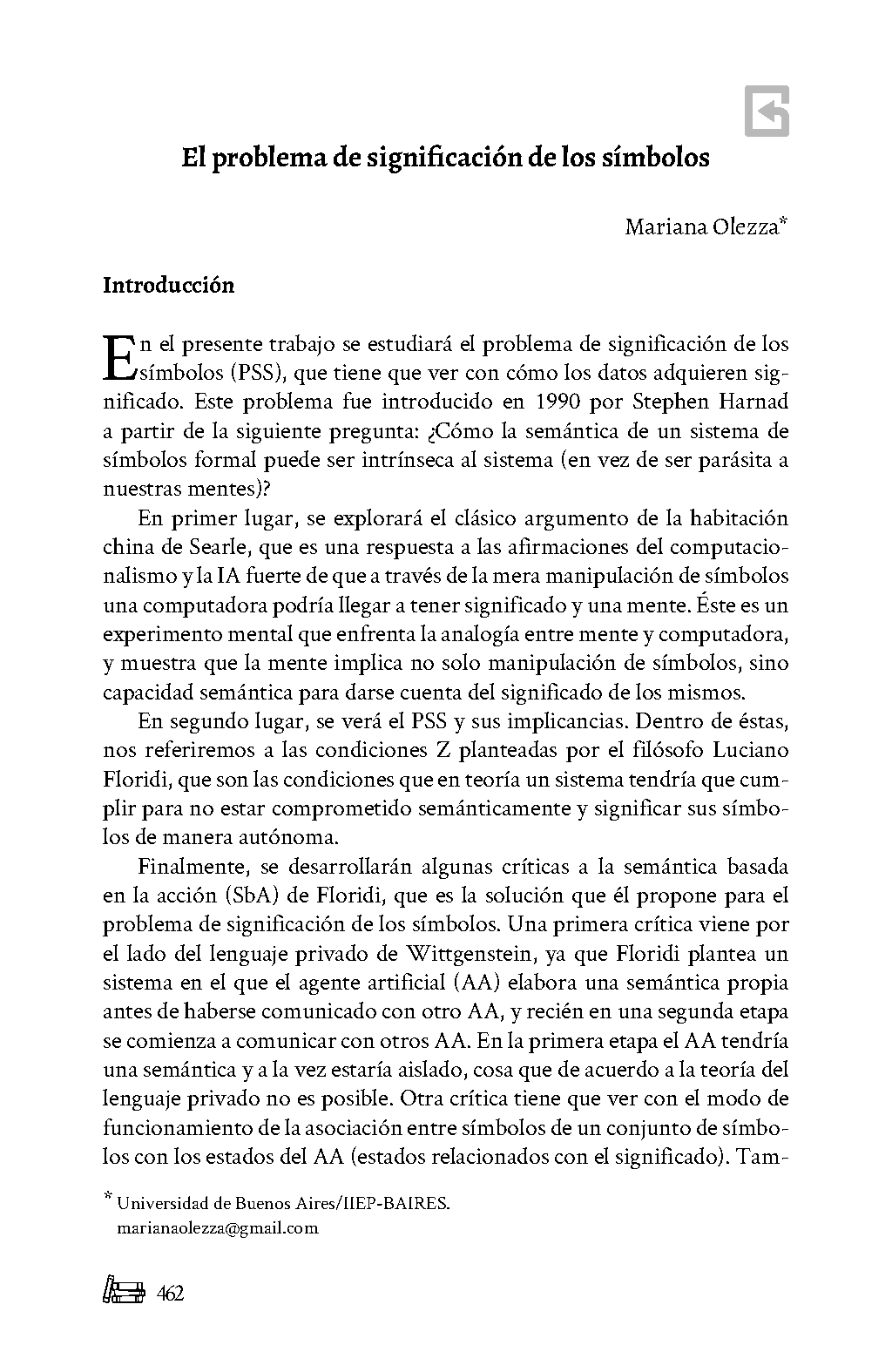El problema de significación de los símbolos
Contenido principal del artículo
Resumen
En el presente trabajo se estudiará el problema de significación de los símbolos (PSS) tal como ha surgido en la inteligencia artificial (IA), que tiene que ver con cómo los datos adquieren significado. Se explorará el argumento de la habitación china de Searle como puntapié inicial al tema. Luego se verá el PSS y sus implicancias, como las condiciones Z planteadas por el filósofo Luciano Floridi, condiciones que un sistema tendría que cumplir para no estar comprometido semánticamente y significar sus símbolos de manera autónoma. Se desarrollarán algunas críticas a la semántica basada en la acción de Floridi, que es la solución que propone él para el PSS.
Detalles del artículo
Sección

Esta obra está bajo una licencia internacional Creative Commons Atribución-NoComercial-SinDerivadas 4.0.
- Los autores/as conservarán sus derechos de autor y garantizarán a la revista el derecho de primera publicación de su obra, el cual estará simultáneamente sujeto a la Licencia de reconocimiento de Creative Commons que permite a terceros compartir la obra, siempre que se indique su autor y su primera publicación en esta revista.
- Los autores/as podrán adoptar otros acuerdos de licencia no exclusiva de distribución de la versión de la obra publicada (p. ej.: depositarla en un archivo digital institucional o publicarla en un volumen monográfico), siempre que se indique la publicación inicial en esta revista.
- Se permite y recomienda a los autores/as difundir su obra a través de Internet (p. ej.: en archivos digitales institucionales o en su página web) antes y durante el proceso de envío.
Cómo citar
Referencias
Cangelosi A. & Riga T. (2006). An embodied model for sensorimotor grounding and grounding transfer: Experiments with epigenetic robots. Cognitive Science, 30(4), 673-689.
Cole, D. (2008). The chinese room argument. En E. N. Zalta (Ed.), The Stanford Encyclopedia of Philosophy (Fall 2008 edition). http://plato.stanford.edu/archives /fall2008/entries/chinese-room/
Floridi, L. (2014). The philosophy of information. Oxford: Oxford University Press.
Floridi, L. (2010). Information: A very short introduction. Oxford: Oxford University Press.
Harnad, S. (2002). Symbol grounding and the origin of language. En M. Scheutz (Ed.), Computationalism: New directions (pp. 143–158). Cambridge, MA.: MIT Press.
Harnad, S. (2000). Minds, machines and Turing: The indistinguishability of indistinguishables. Journal of Logic, Language, and Information, 9(4), 425–445.
Harnad, S. (1990). The symbol grounding problem. Physica Scripta, D(42), 335–346.
Harnad, S. (1987). Categorical perception: The groundwork of cognition. New York: Cambridge University Press.
Müller, V. (2015). Which symbol grounding problem are we trying to solve? Journal of Experimental and Theoretical Artificial Intelligence, 27, 73-78.
Preston, J., & Bishop, M. (Eds.). (2002). Views into the Chinese Room: New essays on Searle and Artificial Intelligence. Oxford: Clarendon Press.
Searle, J. R. (1980). Minds, brains, and programs. Behavioral and Brain Sci- ences, 3(3), 417–457.
Searle, J. R. (1990). Is the brain a digital computer? Proceedings and Ad- dresses of the American Philosophical Association, 64, 21–37.
Searle, J. R. (1992). The rediscovery of the mind. Cambridge, MA; London: MIT Press.
Wittgenstein, L. (1953). Philosophische Untersuchungen. Oxford: Blackwell.
Wittgenstein, L. (1958). The blue and brown book. Oxford: Blackwell.

